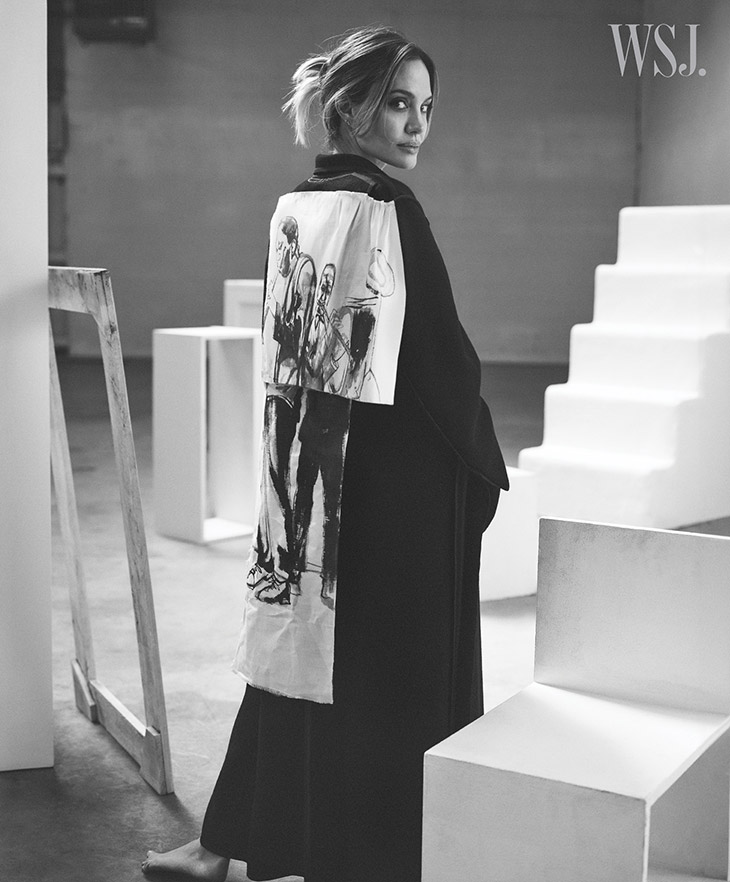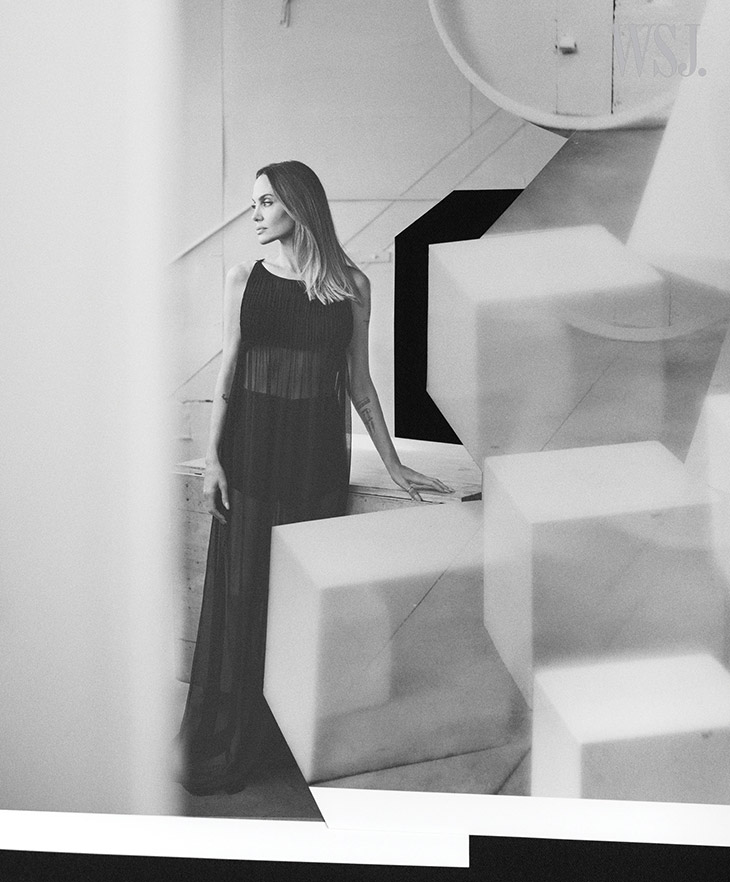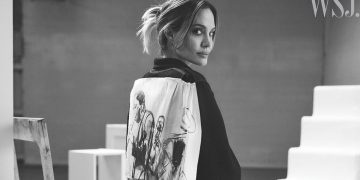
Actress Angelina Jolie takes the digital cover story of WSJ. Magazine‘s December 2023 / January 2024 edition lensed by fashion photographer Annemarieke Van Drimmelen. In charge of styling was Tonne Goodman, with set design from Stefan Beckman, furniture by Dienst + Dotter Antikviteter, and production by 360PM. Beauty is work of hair stylist Diego Da Silva, makeup artist James Kaliardos, and manicurist Eri Handa.
Jolie on her family’s healing over the past seven years: “We had to heal,” she says. “There are things we needed to heal from.”
On expectations placed on actresses today: “I wouldn’t be an actress today,” says Jolie. Maybe theater, she caveats, but not Hollywood. “When I was starting out, it wasn’t as much of an expectation to be as public, to share so much.”
She doesn’t read anything about herself, she says. “I’ve just been around so long, and there’s been everything said.”
On being unimpressed with Hollywood: “Because I grew up around Hollywood, I was never very impressed with it,” says Jolie. “I never bought into it as significant or important.”

On her early fame: Early fame felt crushing. She was depressed and, at points, suicidal, she says. The height of her career arrived as her mother was dying of cancer. Bertrand had taught her to throw on a back- pack and head off on adventures, Jolie says, and this became a coping mechanism. “I wanted to escape,” she says.
On her connection to survivors and refugees: “There’s a reason people who have been through hardship are also much more honest and much more connected, and I am more relaxed with them,” says Jolie. She reflexively answers an inevitable question: “Why do I like spending time with people who’ve survived and are refugees? They’ve confronted so much in life that it brings forward not just strength, but humanity.”
On her social life: “I don’t really have…a social life,” says Jolie. She says she isn’t currently dating.
“I realized my closest friends are refugees,” she says. “Maybe four out of six of the women that I am close to are from war and conflict.”
On her children being her closest friends: Her children have grown up since their days as tabloid fixations, with the oldest out of college and the youngest in high school. Their voices are ones she trusts. “They are the closest people to me and my life, and they’re my close friends,” she says. “We’re seven very different people, which is our strength.”

On how the public views her: The public – meaning, in her case, essentially the entire outside world—has given her a career, she says. “They’ve also chosen how they want you. “Since I was young, people liked the part of me that’s pretty tough and maybe a bit wild—that’s the part that I think people enjoy,” she says. “I’m not the one [who] you want to hear about my pain or my sadness. You know, that’s not entertaining.”
On planning to leave L.A.: Jolie plans to eventually leave L.A. “It’s part of what happened after my divorce. I lost the ability to live and travel as freely. I will move when I can,” she says, and spend more time at her home in Cambodia.
“I grew up in quite a shallow place,” she says. “Of all the places in the world, Hollywood is not a healthy place. So you seek authenticity.”
On her compulsive need to work: “I can’t stop,” she says. “I always think there’s like a fight coming.”

On Atelier Jolie: “If it’s easily explained, it’s probably not going to be as fulfilling as it could be,” she says. “In my life, I’ve never been understood right away.”
On what those around her said when she told them about her new venture: “You, in fashion? No.”
“I’ve never been to a fashion show or Met Ball my entire life,” says Jolie. She has often worked with Versace on custom dresses for major red-carpet moments. Instead of closely following fashion trends, she says, “I love individuality and I love freedom.”
“I’ll probably lose money, maybe even for a while,” says Jolie. “If I can eventually put into practice some things that I think are improvements and I just break even, that’s a huge victory.”

On the philosophy behind Atelier Jolie: “What would be an ethical business? We are trying to reverse-engineer it a little bit,” says Jolie, who began by consulting human rights lawyers before tackling sustainability and circular design. She and her team established a committee to guide the brand’s approach to sourcing and production.
“I don’t know the answers,” says Jolie. “Can we avoid doing real damage—not only to the earth, but the garment workers? … Is it possible that I could go somewhere and enjoy making clothes, enjoy wearing clothes and not hurt anybody? And actually maybe treat people well?”
On what her daughter thinks of her style: Day-to-day, Jolie admits to having a busy-mom uniform that’s more practical than playful: throwing on a coat with her lounge clothes to look elegant while running errands. “My daughter jokes that I wear too many trench coats,” she says, laughing. “It’s just like a hiding thing.”

On her “mom” style: Jolie often relies on Saint Laurent and Celine for a battery of shift dresses, slacks, sweaters and tote bags—chosen, she says, to project an image of unflappable, ladylike safety to her children. For nearly 22 years, she says, “I’ve been a mom, and I’ve fully absorbed that into who I am.”
On being more comfortable than ever in her body: “It’s like I see my scars and my things, and I feel like I’ve lived. And I’m having these big experiences, and I have this map of this complex body that’s changed over time.
“You and I both know that a woman with a full life is very sexy.”

WSJ. Magazine’s December/January 2024 Issue available Saturday, December 9th, read more at wsj.com



















